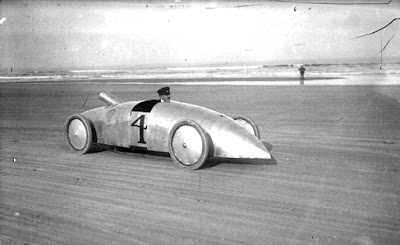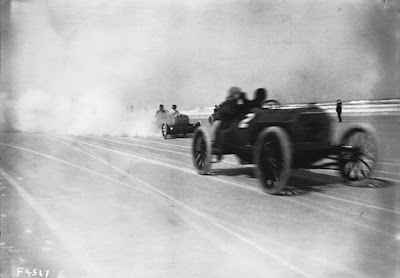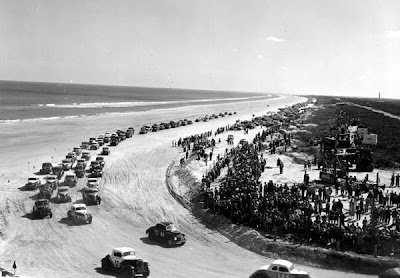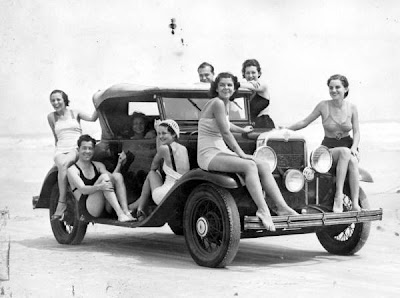 Daytona beach, in Florida (USA), is one of the few places in the world where a family car can be driven on an ocean beach. This was also the beach where automobile racing in America got off a century ago, and where NASCAR competition was born.
Daytona beach, in Florida (USA), is one of the few places in the world where a family car can be driven on an ocean beach. This was also the beach where automobile racing in America got off a century ago, and where NASCAR competition was born.  Daytona's wide beach is still a kind of temple for speed-lovers. Its smooth, compacted sands attracted automobile and motorcycle races in the early 20th century, as pioneers in the industry tested their inventions. These are some of the reasons why this area was nicknamed "The Birthplace of Speed":
Daytona's wide beach is still a kind of temple for speed-lovers. Its smooth, compacted sands attracted automobile and motorcycle races in the early 20th century, as pioneers in the industry tested their inventions. These are some of the reasons why this area was nicknamed "The Birthplace of Speed": 1. The pioneers
By 1902, the people of Florida already drived their bikes and cars throught Daytona beach.
 The automobile had just been invented and men were searching for places where they could drive on hard surfaces. The existing "roads" were horse trails and posed problems for the cars.
The automobile had just been invented and men were searching for places where they could drive on hard surfaces. The existing "roads" were horse trails and posed problems for the cars. By those early years, managers of the Ormond Hotel – next to Daytona beach - decided that a winter automobile racing event was the perfect promotional tool for the Hotel. Their rooms began to be frequented by such people as Henry Ford, Harvey Firestone, Thomas Edison, and John D. Rockefeller. All of them agreed that the sands of Daytona and Ormond were the perfect place for racing and testing their new cars.
By those early years, managers of the Ormond Hotel – next to Daytona beach - decided that a winter automobile racing event was the perfect promotional tool for the Hotel. Their rooms began to be frequented by such people as Henry Ford, Harvey Firestone, Thomas Edison, and John D. Rockefeller. All of them agreed that the sands of Daytona and Ormond were the perfect place for racing and testing their new cars.
2. The competition
In the followig years, those millionaire pilots celebrated several tournaments to test their cars. According to Bob Alexander, “between 1903 and 1935, dozens of world land speed records were set on the Florida beaches".
 The men and machines continued to come to Daytona Beach to test their skill against the timer's clock. One by one the world speed records were pushed higher and higher as the cars became more powerful and equipped with new technology.
The men and machines continued to come to Daytona Beach to test their skill against the timer's clock. One by one the world speed records were pushed higher and higher as the cars became more powerful and equipped with new technology. In 1947, a young auto mechanic and weekend dirt-track racer, Bill France, began organizing stock car races on the beach and formed a new sanctioning body, the National Association for Stock Car Automobile Racing, or NASCAR, in Daytona Beach.
In 1947, a young auto mechanic and weekend dirt-track racer, Bill France, began organizing stock car races on the beach and formed a new sanctioning body, the National Association for Stock Car Automobile Racing, or NASCAR, in Daytona Beach.  In 1959, the construction of the Daytona International Speedway was completed. A high-banked 2.5-mile tri-oval track. The first Daytona 500 was run on February 22, 1959. More than 41,000 fans witnessed a race.
In 1959, the construction of the Daytona International Speedway was completed. A high-banked 2.5-mile tri-oval track. The first Daytona 500 was run on February 22, 1959. More than 41,000 fans witnessed a race. 

3. Getting popular
Because of the races, the popularity of Daytona beach suddenly increased, and plenty of people used to come with their cars to spend a day at the beach.

 In some special events, there were hundreds of cars gathered from all across the country.
In some special events, there were hundreds of cars gathered from all across the country. 

4. The beach nowadays
 Today, cars can still access to the beach, but the times of glorious races seem so far away. Authorities have delivered traffic signs with new speed limits or indicating the lanes.
Today, cars can still access to the beach, but the times of glorious races seem so far away. Authorities have delivered traffic signs with new speed limits or indicating the lanes. Of the 23 miles of beach, 16 miles allow driving and parking during the day and when the tide permits. The sand becomes softer as one moves further inland from the waterline.
Of the 23 miles of beach, 16 miles allow driving and parking during the day and when the tide permits. The sand becomes softer as one moves further inland from the waterline. 
 Unfortunately, some days the amount of people and cars is so high, that there's finally a real traffic jam on the beach.
Unfortunately, some days the amount of people and cars is so high, that there's finally a real traffic jam on the beach.  Most of the pictures are courtesy of George Eastman House.
Most of the pictures are courtesy of George Eastman House.More info and sources: 1, 2, 3, 4, 5, 6, 7 / Images: 1, 2, 3, 4, 5


 2 ... 2 ...
2 ... 2 ...
0 comments:
Post a Comment